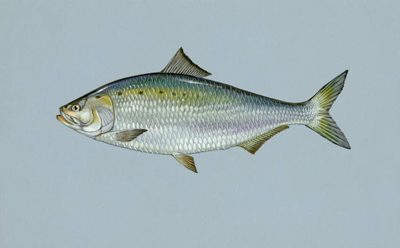Dam Removal and the American Shad

In 1805, one of my ancestors, Stephen Grissom, signed a petition to the state’s General Assembly on behalf of American shad. The petitioners were concerned that mill dams on the Uwharrie River blocked the passage of this migratory fish. The petition says those living on or contiguous to the river were “being deprived of the benefits that providence by nature has bestowed upon us…” As recourse, they asked state legislators to require mill dams to be opened during the spring shad run.
American shad (Alosa sapidissima) spend most of their life in the ocean, but, like salmon, they migrate upstream to spawn. Inland subsistence farmers like Stephen Grissom depended on the shad run to supplement their diets. Farther east, entire communities were built around commercial shad fishing. Shad have also been associated with some of the defining moments in our nation’s history.
Some people claim an early shad run saved George Washington’s troops from starvation after a devastating winter at Valley Forge. Alas, it’s a notion based less on fact than on a sentimental attachment to the fish. There’s better evidence linking shad to the outcome of a decisive battle in the last days of the Civil War. On April 1, 1865, Confederate general George Pickett was south of the Appomattox River, defending the last supply line to Richmond against General Sheridan’s advancing Union troops. According to historian Shelby Foote, Pickett slipped away from his battle station to enjoy a midday shad bake along the banks of Hatcher’s Run. When the fighting commenced, he was miles away. His troops were in disarray without their leader. By the time he returned, half his division had been captured or shot, a rout that probably hastened the end of the war.
When the non-profit advocacy group American Rivers approached us about removing a small, outdated dam to help restore the shad run on the Uwharrie River, how could we say no to such a storied fish?
 Their request was prompted by terms of Progress Energy’s recent Federal Energy Regulatory Commission (FERC) relicensing agreement. It includes provisions to improve access to habitat for migratory fish populations in areas impacted by their dams. Beginning as early as 2013, Progress Energy will have thousands of shad collected from the Pee Dee River below Blewett Falls and trucked to the river above Tillery. Once released, they’ll continue to migrate upriver, searching for a place to lay their eggs. After hatching, juvenile shad will remain in our creeks and rivers until they begin their long journey back to the ocean in fall. Progress Energy will install facilities necessary to provide adequate downstream passage.
Their request was prompted by terms of Progress Energy’s recent Federal Energy Regulatory Commission (FERC) relicensing agreement. It includes provisions to improve access to habitat for migratory fish populations in areas impacted by their dams. Beginning as early as 2013, Progress Energy will have thousands of shad collected from the Pee Dee River below Blewett Falls and trucked to the river above Tillery. Once released, they’ll continue to migrate upriver, searching for a place to lay their eggs. After hatching, juvenile shad will remain in our creeks and rivers until they begin their long journey back to the ocean in fall. Progress Energy will install facilities necessary to provide adequate downstream passage.
Since the Uwharrie is the only major tributary into Lake Tillery, it’s important to make as much of it accessible as possible. Removing this small, outdated dam will open up an additional 15 miles of the river’s main stem and 189 miles of perennial streams, enough habitat to support an additional 7,000 shad. These impressive figures made this project one of the top priorities in the southeast for the Community-based Restoration Program which is jointly administered by American Rivers and the National Oceanic and Atmospheric Administration. Removal of the dam is a two-phase process. Funds for the study phase of the project were recently awarded. Once those results are available, American Rivers will apply for additional funds to do the actual removal.
Doing so will not only provide shad access to historic spawning grounds, it will also improve habitat for many other species, including several endangered mussels. And as Lynnette Batt with American Rivers says, “What’s good for shad is good for striped bass.” When the shad return, anglers can look forward to tangling with a feisty sport fish, one that doesn’t tire easily. In The Founding Fish, John McPhee describes his epic 2 ½-hour battle with a 4 ¾-pound roe shad.
A grist mill at the site dates back to the 1780s, so this particular dam must have been one of those that prompted 136 men to join Stephen Grissom in signing the petition in 1805. Their surnames create a directory of early landowners in the Uwharrie River valley – Allen, Callicutt, Cranford, Davis, Green, Grissom, Hall, Harris, Hopkins, Hurley, Luther, Morgan, Russell, Sanders and Simmons. More than 200 years later, many of their descendants still live here. And we still care about the river.
At first glance, tearing down this dam might seem to run counter to the goals of historic preservation, but in this case, I believe removing this relic from our past actually helps us reconnect with another aspect of our history. In the future, perhaps we’ll be able to experience the spring shad runs that inspired our ancestors to include this statement in their petition: “the river Uhary is an excellent river for fish, especially the white shad.”
Top Photograph by Mark Cantrell of the United States Fish and Wildlife Service (USFWS). Image of American Shad courtesy of the USFWS National Digital Library.